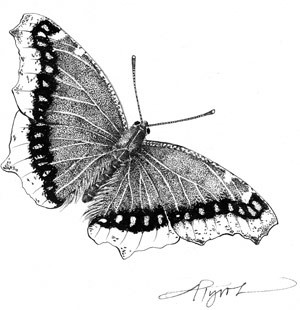
For the past six months they flickered among us—tiny flashes of red, orange, yellow and blue floating above hayfields and dancing in flower gardens: spring azures, great spangled fritillaries, red admirals, monarchs and more than 100 other butterfly species. But when a hard frost or freeze comes to northern New England, the butterfly will vanish. The last butterfly of the year, probably a clouded sulphur somewhere in the Champlain lowlands or near the New Hampshire seacoast, will flutter no more. Winter will finish off the 2008 butterfly season.
Or will it?
We often think of adult butterflies as the dominant phase in the life cycle of these insects. It is certainly the most elegant. After all, when you find your first early hairstreak of springtime, a prized butterfly about the size of a thumbnail, colored in cobalt blue and mint green, marked with little orange lightning bolts, you may want to quit your job and become a lepidopterist. Adult butterflies surely get the glory, but most butterfly species live on the wing for only a week or two. Their primary role in life is to fly around and make more butterflies.
But by November most of these butterflies are frolicking no more. A few species migrate, including the well-known monarch, which heads off to Mexico. Most of the rest stay close to home over the winter – but not in the adult stage. Depending on the species, they remain beneath the snow as either an egg, caterpillar, or pupa. They employ a form of hibernation, which sees them through winter. By the following spring, each form will pick up where it left off in the progression from egg to caterpillar to pupa to adult.
But even through the coldest months of winter some adult butterflies remain among us. You want audacity of hope? Find it in the select species that survive New Hampshire and Vermont winters as adults.
One of them is the mourning cloak, with chocolate brown wings that feature a row of blue jewels above buttery yellow wing edges. Mourning cloaks are rather pugnacious butterflies. Males take a favorite perch and dart out at most anything that floats or wanders by, including people. The mourning cloak has a long life span by butterfly standards. By now, as the day length wanes and temperatures drop, this butterfly, like a black bear to a den, will seek out a cavity in which to pass the winter. On a crisp fall day, I once watched a mourning cloak crawl between the layers of a black fleece jacket hanging on my clothesline. But it will often select a more secure place: in fissures between tree bark or in a slot beneath a loose clapboard on a house.
Antifreeze is the key to wintertime butterfly survival. Over-wintering insects often build up reserves of lipids – body fat – and thicken their innards by manufacturing glycerol or similar compounds, which displace water and protect them from freezing temperatures. There, in a cozy cavity, the mourning cloak will wait, usually until the warm days of spring.
But sometimes they launch before spring. On warm, sunny days of March, when the maple sap is running, some mourning cloaks take flight. And they won’t be alone. Marauding around in late March and April are small numbers of over-wintering Milbert’s tortoiseshells, sporting a shocking orange stripe across dark wings; eastern commas, which actually have a comma-shaped mark under their hind wings; and a few other enterprising species. Some rouse simply because their winter resting spots heat up fast in focused sunlight; others may find their way into – and fly within– garages or homes (where it’s tough to find a butterfly mate). The Vermont Butterfly Survey (www.vtecostudies.org/VBS/), which is tracking butterfly abundance and distribution, has documented butterflies in flight in every month of the year except December, January and February.
There is some evidence that butterflies are making earlier appearances. In Great Britain, where scientists and ordinary folks have been watching and documenting butterfly behavior for decades, researchers have found that butterflies are breaking records for early-season flights. Some researchers suggest that butterflies can be viewed as sensitive indicators of a warming planet.
For some, butterflies in flight on Valentine’s Day might be a welcome sight. But in mid-February I would rather see snowflakes than a mourning cloak.

